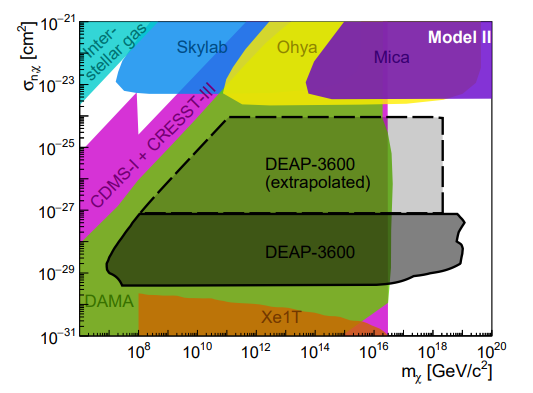...
Process | Info | Signature | Selection | Background rate | Limits on signal rate | Limits on model parameters | Current limits |
|---|---|---|---|---|---|---|---|
Theory | Theory | Exp | Exp | Exp | Theory | Theory | |
Geometric cross-section |
| ‘Track’ in liquid scintillator detector. Multiple sub-threshold scattering events (~few keV per scatter) , but total energy deposited along track can be above threshold. | I’ll assume scatters are low-energy enough that they generate single photoelectron signals in a scatter. Simplest selection would be to observe N 1 PE events over a time period consistent with DM crossing the detector. Crossing time ~3 m / 10-3 c, so 10 microseconds. There’s definitely scope for improvement with these selections – the lowest-hanging fruit would be to look for events consistent with a down-going track (top PMTs fire first, bottom ones later). | The dark rate will dominate the event rate at 1 PE. I’ll assume a dark rate of 400 Hz for all PMTs, but can recalculate pretty easily. The accidental rate will depend upon the N-fold coincidence in ~10 us used for identifying these events. For 2-fold coincidences, the background rate is 473 Hz. For 3.2 -fold coincidences, the background rate is 15 Hz. For 4-fold coincidences, the background rate is 0.3 Hz. For 35-fold coincidences, the background rate is 19 4.2 mHz. For 46-fold coincidences, the background rate is 102 43 uHz. For 57-fold coincidences, the background rate is 512 34 nHz. For 68-fold coincidences, the background rate is 2.5 2 nHz, which is 0.2 events in 3 years. NB: the dark count rates for the veto PMTs will be measured soon, so we could flesh this out with more realistic numbers in a couple of months' time. | Assuming 3 years of running and a background entirely due to singles, 90% of experiments would have a difference from the expectation rate of less than: 236 uHz 2.8 mHz for 2-fold coinc. 18 510 uHz for 3-fold coinc. 1.3 72 uHz for 4-fold coinc. 90 nHz 8.5 uHz for 5-fold coinc. 11 824 nHz for 6-fold coinc. 29 nHz for 7-fold coinc. 8.4 nHz for 8-fold coinc (this corresponds to 1 gives ~1 count). These numbers effectively modify the right hand edge of the limit space, depending on which coincidence level we choose, if we assume 100% signal efficiency. The bottom edge of the limits is set by the average energy deposit required to pass the trigger. This sort of veto event hasn’t been well-studied by SABRE. We claim a 50 keV threshold for two veto PMTs firing within ~few 10’s of nanoseconds. Correcting for a quenching factor of 0.2, 250 keV might be a good first estimate for the 2-fold coincidencescoincidence threshold. For the higher coincidences, I’m just going to I’ll assume the energy deposit scales linearly (probably incorrect but we’re being quite rough anywaybut a first guess). This would give a threshold of 250*N/2 keV for an N-fold coinc. | With area of 5.3m2 and 3 years run time, sensitive to mDM < 1019 GeV (assuming zero background). | |
DM-nucleus cross-section scales as A4 | ‘as above’ | ‘as above’ | ‘as above for mass reach’. Cross-section reach is a factor of A4 lower: |
...

